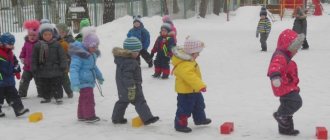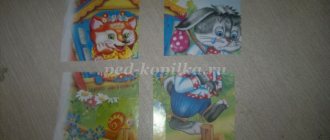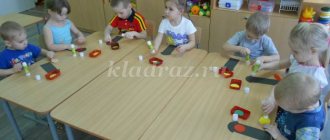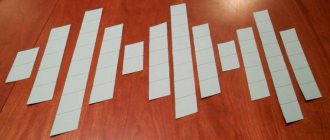Outdoor games for children aged 4-5 years
Game "Hot Ball"
Children stand in a circle and pass the ball to each other to the music. When the music stops, the player who did not have time to pass the ball and remains in his hands is eliminated. The last participant left without a ball wins.
Outdoor game for preschoolers “Cat and Mouse”
In one corner of the site there is a cat’s house, in another there is a mouse hole, in the third there is a pantry with imaginary food. The cat falls asleep in the house, and the mice run from the hole to the pantry. At the leader’s signal, the cat wakes up and begins to catch mice that are trying to run to the hole.
Game "Spider and Flies"
In one corner of the site there is a web in which the “spider” sits. The rest of the children pretend to be flies: running, circling, buzzing. The presenter shouts: “Spider!” The flies freeze in place. The spider comes out of the web and carefully looks to see who is moving. He takes the one who moves into his web.
Outdoor game for children aged 4-5 years “Find yourself a mate”
To carry it out, you need to prepare flags in advance (according to the number of participants - 2 flags of each color, one flag must be left without a pair). An odd number of children take part in the game. Each child receives one flag. At the leader’s signal, the children scatter around the playground. At another signal (for example, after the words “find a pair”), children with the same flags stand next to each other. One child is left without a partner. Turning to him, all the players say: Player’s name (Tanya, Sasha...), don’t yawn! Quickly choose a couple. The children scatter around the playground again and the game repeats.
Game "Edible - Inedible"
The players line up in a row. The presenter throws the ball to one of the players and says a word. The player must catch the ball if the word denotes an edible item, or throw it away if the item is inedible. The most attentive one wins.
JUMPING AND JUMPING EXERCISES
Target.
Teach children to hop on two legs, landing softly, jump over a cord, jump from low objects, listen carefully to signals, perform movements in accordance with signals or text that the teacher pronounces.
#1 “Jump up to your palm.”
The teacher calls first one or the other child to him and invites him to jump higher so that his head touches his palm.
Instructions for carrying out.
The exercise is performed individually with each child. The hand should be kept at a short distance from the child's head. If the baby jumps up to his palm without difficulty, the teacher can raise it higher. Bouncing exercises should be performed in light shoes (slippers, shoes).
You can invite kids to jump like balls or like bunnies. Several children can participate in this exercise. The teacher shows and prompts that you need to jump higher and gently lower yourself to the floor.
No. 2 “Jump the cord.”
Children sit on chairs. The teacher places a colored cord (3-4 m long) on the floor. Children (6-8 people) approach the cord and, at the teacher’s signal, try to jump over it.
Instructions for carrying out.
You can put 2-3 cords of different colors at a short distance from one another. Children, having jumped over one cord, go to another and jump over it.
However, children of this age should not be offered more jumping exercises. Children of the third year of life perform the simplest jumps and jumps with great interest in story games. As the game progresses, the child can easily jump and jump several times without focusing on these movements.
No. 3 “Through the stream.”
Two lines are drawn on the site at a distance of 15-20 cm - this is a stream. Indoors, you can place two cords on the floor at the same distance. Several children are asked to come closer to the stream and jump over it, pushing off with both legs at once.
Instructions for carrying out.
The teacher can tell the children that the stream is deep, so they need to jump as far as possible so as not to fall into it and not get their feet wet.
The exercise can be performed by 4-5 children at the same time. The distance between the lines should be gradually increased to 30-35 cm. The teacher makes sure that the children push off harder and land softly, bending their knees.
No. 4 “From hummock to hummock” (II option).
On the playground, the teacher draws small circles with a diameter of 30-35 cm. The distance between the circles is approximately 25-30 cm. These are hummocks in the swamp, along which you need to get to the other side. The child called by the teacher approaches the circles and begins to jump on two legs from one circle to another, moving forward. Having thus moved to the other side of the site, he walks back. Then the next person performs the exercise.
Instructions for carrying out.
When performing this exercise indoors, you can use cardboard circles or flat plywood hoops of the same diameter. First, the children perform the exercise one at a time, and then you can give the task of jumping from hummock to hummock to 2-3 children at once.
No. 5 “Touch the ball.”
An adult holds a small ball in a net. He invites the child to jump up and touch the ball with both hands. One child jumps up 3-4 times, then the teacher invites the other children to jump.
Instructions for carrying out.
Instead of a ball, the teacher can hold a bell or rattle in his hands. Depending on the height of the children and their capabilities, the adult adjusts the height of the ball and bell. A bell or rattles can be hung on a stretched cord so that they are slightly higher than the child’s outstretched arms. The teacher makes sure that the children, while jumping, try to touch the object with both hands, this will ensure uniform development of the muscles of the shoulder girdle.
No. 6 “Catch a mosquito.”
Children stand in a circle at arm's length, facing the center of the circle. The teacher is in the middle of the circle. In his hands he holds a rod 1-1.5 m long with a mosquito made of paper or cloth tied to a cord. The teacher circles the cord slightly above the heads of the players - a mosquito flies overhead; the children jump up, trying to catch it with both hands. The one who catches the mosquito says: “I caught it.”
Instructions for carrying out.
We must ensure that children do not make the circle smaller when bouncing. Rotating the rod, the teacher either lowers or raises it, but to such a height that the children can reach the mosquito.
No. 7 “Turn around yourself.”
The teacher invites one child or several children to jump on two legs in place with a turn. Children stand at a short distance from each other facing the teacher and, at his signal, begin to jump. With each jump, they make a slight turn to one side (left or right) so that after a few jumps they return to their original position. Then the exercise can be repeated, turning in the other direction.
Instructions for carrying out.
Before children begin to perform this exercise, the teacher must show how it is performed. We must ensure that children jump higher and gently land on their toes. They hold their hands freely and can swing them when jumping. When the kids learn to jump well, they can be asked to put their hands on their belts. This exercise can be done in small groups or the whole group of children at the same time.
No. 8 “Jump to the flag.”
The teacher draws a line on the playground and places stands with flags at a distance of 2-3 m from it. He then invites two or three children to walk up to the line and jump on two legs, moving forward until they reach the flags. When the children are at the flags, they should pick them up, wave them and put them back in place. They come back running.
Instructions for carrying out.
The teacher first shows how to do the exercise. He makes sure that when children jump, they push off with both legs at the same time and land softly, and encourages those who are not yet very good at jumping. The teacher can, at his discretion, increase or decrease the distance for jumping.
No. 9 “Jump into a circle.”
The teacher places a low bench (10-12 cm), and in front of it draws circles on the ground (30-35 cm in diameter). He invites the children (according to the number of circles) to stand on a bench and jump from it into the circles. Others stand on the bench.
Instructions for carrying out.
It is necessary to ensure that children, standing on the bench, do not interfere with each other; when jumping, they land on both feet at once with their toes and bending their knees. You can invite them to jump so quietly that no one hears. This will encourage them to perform the jump more correctly.
The duration of exercises with jumping for children should be short, since in children of this age the foot muscles have not yet become stronger (this must be especially remembered when performing jumping). Gradually, towards the end of the children’s stay in the second younger group, the number of jumps should increase.
No. 10 “Through a string.”
The teacher and one of the older children hold a jump rope or a small rope by the ends so that its middle touches the ground. Several children are asked to jump over a rope. They take turns coming up and jumping over the rope, pushing off with both feet.
After everyone jumps over the rope lying on the ground, it can be raised first by 2-3 cm, and then higher.
Instructions for carrying out.
One end of the rope can be tied to a stand or tree, the other needs to be held in your hands not too tightly. If the jumper touches the rope, then its end must be released from the hands so that the child does not fall.
When the rope is lifted, the teacher should tell the children that now, in order to jump higher and not touch it, they need to push off harder. The height of the rope should be increased gradually in accordance with the capabilities of the children.
7. GAMES - FUN
Target.
Entertain children, help create a good, joyful mood in them, have fun.
No. 1 “Hide and Seek”.
Description.
The teacher invites the children to hide with him from the nanny, who at this time should turn away and not look where they are hiding. Children and the teacher go behind the closet or sit down on the carpet, and the teacher covers them with a transparent scarf. The teacher asks the nanny: “Where are our children? Aunt Katya, have you seen them? The nanny begins to look for the children, deliberately looking in other places. The kids jump out of their hiding place with delight and run up to her with cheerful laughter. The nanny hugs them and says affably: “Where did you hide so that I couldn’t find you?”
Instructions for carrying out.
After the children have hidden with the teacher several times, they will be able to hide on their own, and the teacher will look for them. The teacher can also hide, then the children look for him. It gives them great pleasure. After repeated repetitions of the game, even a child will be able to search for children.
No. 2 "Blind Man's Bluff".
Description.
The teacher invites the children to disperse around the room. He closes his eyes or ties them with a scarf and pretends that he is trying to catch the children: he carefully moves around the room and catches children where they are not. Children laugh. The teacher asks: “Where are our children?” Then he takes off the bandage, turns towards the children and says: “That’s where our children are!”
Instructions for carrying out.
In this game, the teacher plays an active role. He acts carefully so as not to scare the children, but only to amuse them.
Instead of a bandage during the game, you can use a bright paper cap (cone), which is worn deeply, covering the upper part of the face.
No. 3 “Blind Man’s Bluff with a Bell” (complicated version).
Description.
One of the children is given a bell. The other two children are blind man's buff. They are blindfolded. The child with the bell runs away, and the blind man's buff catches up with him. If one of the children manages to catch the child with the bell, then they change.
Instructions for carrying out.
For this game, you need to limit the space, since in a large space it is difficult for kids to catch children, especially with their eyes closed.
No. 4 “Give the bunny a carrot.”
Description.
Children sit on benches on the veranda or playground. One of them, the more prepared one, is given a carrot, which he must give to the toy rabbit. The child stands at a distance of 3 m from the rabbit and is blindfolded. The kid must go up to the rabbit and give him a carrot (bring the carrot to the rabbit's face).
Instructions for carrying out.
Usually the child fails to immediately complete the task accurately and his actions cause laughter among the other children. Therefore, the driver in this and similar games is appointed at will.
No. 5 “Soap Bubbles”.
Description.
To play, you need to prepare plastic tubes or straws (ripe rye or wheat) for the number of children, dilute soapy water in a small saucer or bowl. All children receive straws and try to blow a soap bubble. If this is successful, they enthusiastically blow soap bubbles, watch them fly, run after them, and see whose bubble flew longer and did not burst.
Instructions for carrying out.
First, you need to show the children how to make a soap bubble: dip one end of the straw into soapy water, then, taking it out of the water, carefully blow from the other end.
No. 6 “Water the horse.”
Description.
The game conditions are the same as in the game “Give the rabbit a carrot.”
The child stands behind the line at a distance of 2-3 m from the toy Horse. The teacher gives him a bucket and blindfolds him.
The kid must go up to the horse and give it water (bring the bucket to the horse’s face).
Instructions for carrying out.
For the game, it is advisable to take a large horse that children can sit on. This will make it easier for them to complete the task - they can water the horse without bending over.
The teacher calls the children only at their request. If none of them expresses a desire to start first, then the teacher can try to complete the task himself. You can invite one of the children in the senior or preparatory school group to participate in the game. Let the younger children watch first, laugh at the loser, and then try to play themselves.
No. 7 “Hit the ball.”
Description.
The game is played in the hall or on the court. You need to hit the ball blindfolded. The teacher places a large ball on the floor (ground) and draws a line at a distance of 2-3 m from it. A child who has agreed to complete the task approaches the ball, stands with his back to it, then moves to the line and turns to face the ball. The teacher blindfolds him. The driver must approach the ball and kick it.
Instructions for carrying out.
If the task is completed successfully, then another child is called. If the hit on the ball was unsuccessful, then you can invite the same child to repeat the task. If failure upsets the child, you need to encourage him, tell him that next time he will definitely succeed.
The driver in this game is appointed according to his wishes.
Game "Traffic Light"
We choose a driver. Players stand on one side of him at a distance of five steps. The driver turns away from the players and names any color. Participants must find this color in their clothes, and holding onto it, they can freely move to the other side. The player who does not have this color must run to the opposite side to avoid being caught. Whoever gets caught becomes the driver.
These are the outdoor games we propose for children 4-5 years old to play outdoors. Kids will definitely love them!






